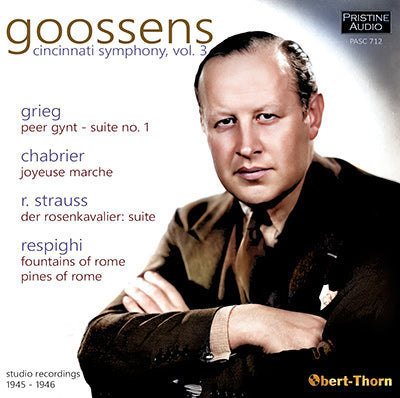
This album is included in the following sets:
This set contains the following albums:
- Producer's Note
- Full Track Listing
- Cover Art
This volume is the last of three in a series presenting the complete recordings of Eugene Goossens and the Cincinnati Symphony Orchestra. Goossens was born into a musical family in London in 1893. His Belgian grandfather had been a conductor; his father, a violinist; his mother, an opera singer; and his siblings all noted instrumentalists (oboist Léon, harpists Sidonie and Marie and hornist Adolphe). After studying violin and playing in various London orchestras and chamber ensembles, Goossens became an assistant to Beecham in 1916. By 1921, he had taken up conducting full-time, forming his own orchestra, and making a particular specialty of new music. In the same year, he gave the British concert première of Stravinsky’s The Rite of Spring.
At the invitation of George Eastman, Goossens served as music director of the Rochester Philharmonic and taught at the Eastman School of Music from 1923 to 1931, splitting his time between the USA and Britain, where he continued to conduct in the concert hall and at Covent Garden. He led the Hollywood Bowl Orchestra frequently during his years in America, and made recordings there in 1928. From 1931 through 1946, he headed the Cincinnati Symphony before moving to Australia to conduct the Sydney Symphony (1947-56) and lead the New South Wales State Conservatorium of Music, where among his students were Joan Sutherland and Richard Bonynge. He was knighted in 1955; but his career suffered from a scandal the following year which caused his return to the UK. He died in 1962.
The Cincinnati Symphony had already enjoyed an illustrious history before Goossens’ arrival. Its previous music directors had included Leopold Stokowski (1909-12), violinist-turned-conductor Eugene Ysaÿe (1918-22) and Fritz Reiner (1922-31). Although the ensemble had recorded acoustically under Ernst Kunwald and Ysaÿe in 1917-19, they had not made any discs in over two decades until Goossens’ first sessions in February, 1941.
The program presented here comes from his last two recording dates with the orchestra. Grieg’s incidental music to Peer Gynt must have been a favorite of Goossens’, as he had already recorded the first suite twice before in London (1926 and 1937) before he set down this final version in Cincinnati. His interpretation is warm, flowing and replete with characterful detail.The short, exuberant Chabrier march was issued as a filler side to Goossens’ recording of Stravinsky’s Le Chant du rossignol (reissued on Volume 2 of this series, Pristine PASC 691).
Goossens was perhaps the only conductor to have recorded Antal Doráti’s arrangement of a suite from Richard Strauss’ Der Rosenkavalier other than Doráti himself, who recorded it three times. It contains the same general selections from the opera in the same order as the now-standard suite attributed to Artur Rodziński, but with some variations in the music bridging each section. One major difference is that Doráti managed to include the entire Introduction to Act 3 in his arrangement, which Goossens and his Cincinnatians dispatch with virtuosic gusto.
During his last session in Cincinnati, Goossens recorded the first two tone poems of Respighi’s Roman Triptych. Most likely, they were originally intended to be issued together in a four-disc album. However, RCA Victor initially only brought out Pines of Rome a couple years after Goossens had left Cincinnati for Australia. The Fountains remained unpublished for decades, briefly appearing in a limited-edition LP set. Both scores show Goossens to be a master colorist. Goossens would go on to re-record Fountains for a stereo HMV LP, and conclude the trilogy with a Feste Romane on Everest.
Mark Obert-Thorn
GOOSSENS Cincinnati Symphony, Vol. 3
GRIEG Peer Gynt – Suite No. 1, Op. 46
1. 1. Morning Mood (3:41)
2. 2. The Death of Åse (4:27)
3. 3. Anitra's Dance (3:14)
4. 4. In the Hall of the Mountain King (2:15)
Matrices: D5-RC-665/8 ∙ First issued on RCA Victor 11-8864/5 in album SP-10
5. CHABRIER Joyeuse Marche (4:12)
Matrix: D5-RC-682 ∙ First issued on RCA Victor 11-9096 in album M-1041
6. R. STRAUSS (arr. Doráti) Suite from Der Rosenkavalier, Op. 59 (23:45)
Matrices: D5-RC-676/81 ∙ First issued on Victor 11-8783/5 in album M-997
RESPIGHI Fountains of Rome
7. 1. The Fountain of Valle Giulia at Dawn (4:04)
8. 2. The Triton Fountain in the Morning (2:11)
9. 3. The Trevi Fountain at Noon (3:01)
10. 4. The Villa Medici Fountain at Sunset (5:18)
Matrices: D6-RC-5143/6 ∙ Unissued on 78 rpm
RESPIGHI Pines of Rome
11. 1. The Pines of the Villa Borghese (2:33)
12. 2. Pines Near a Catacomb (5:29)
13. 3. The Pines of the Janiculum (5:37)
14. 4. The Pines of the Appian Way (4:44)
Matrices: D6-RC-5147/50 ∙ First issued on RCA Victor 12-0941/2 in album DM-1309
Cincinnati Symphony Orchestra
conducted by Eugene Goossens
Producer and Audio Restoration Engineer: Mark Obert-Thorn
Special thanks to Nathan Brown and Charles Niss for providing source material
Recorded 25 February 1945 (Grieg, Chabrier, Strauss) and 14 February 1946 (Respighi) in the Cincinnati Music Hall, Cincinnati, Ohio
Total duration: 74:30

